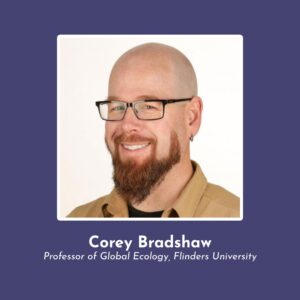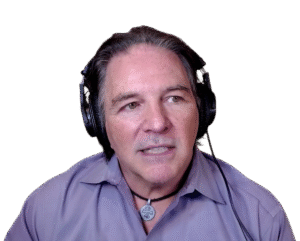
Show Summary
Human overpopulation is often depicted in the media in one of two ways: as either a catastrophic disaster or an overly-exaggerated concern. Yet the data understood by scientists and researchers is clear. So what is the actual state of our overshoot, and, despite our growing numbers, are we already seeing the signs that the sixth mass extinction is underway?
In this episode, Nate is joined by global ecologist Corey Bradshaw to discuss his recent research on the rapid decline in biodiversity, how population and demographics will change in the coming decades, and what both of these will mean for complex global economies currently reliant on a stable environment.
How might the current rate of species loss result in a domino effect of widespread and severe impacts on the health of the biosphere? What are the key factors driving changes in population growth, and how do these vary across different countries and cultures? Could we stabilize these trends and achieve a sustainable balance between biodiversity and human population through targeted policies and initiatives — and how much time is left to act?
About Corey Bradshaw
Corey Bradshaw is the Matthew Flinders Professor of Global Ecology and Director of the Global Ecology Laboratory at Flinders University in South Australia. He is also the head of the Flinders Modelling Node of the Centre of Excellence for Australian Biodiversity and Heritage. He has completed three tertiary degrees in ecology (BSc, MSc, PhD) from universities in Canada and New Zealand, and a Certificate in Veterinary Conservation Medicine from Murdoch University.
In a world where human activity has precipitated the current Anthropocene extinction event, he aims to provide irrefutable evidence to influence government policy and private behavior for the preservation of our planet’s biowealth. He has published over 300 peer-reviewed scientific articles, 13 book chapters and 3 books, including The Effective Scientist and Killing the Koala and Poisoning the Prairie.
In French, we have a motto that says that a simple drawing is often better than a long explanation. Jean-Marc Jancovici Carbone 4 President
That’s very understandable because with left atmosphere thinking, one of the problems is that you see everything as a series of problems that must have solutions. Iain McGilchrist Neuroscientist and Philosopher
We can’t have hundreds and hundreds of real relationships that are healthy because that requires time and effort and full attention and awareness of being in real relationship and conversation with the other human. Nate Hagens Director of ISEOF
This is the crux of the whole problem. Individual parts of nature are more valuable than the biocomplexity of nature. Thomas Crowther Founder Restor
Show Notes & Links to Learn More
00:00 – Corey Bradshaw works + info, Global Ecology Laboratory, ARC Centre of Excellence for Australian Biodiversity and Heritage
Papers discussed in this episode: Coextinctions dominate future vertebrate losses from climate and land use change
Long-term benefits of curbing human population growth
Human population reduction is not a quick fix for environmental problems
Underestimating the challenges of avoiding a ghastly future
Co-extinctions annihilate planetary life during extreme environmental change
Testing the socioeconomic and environmental determinants of better child-health outcomes in Africa
06:16 – Fur trappers and conservation in British Columbia
06:53 – Population of furbearing species in British Columbia: Grizzly Bears + Bobcats and Lynx
07:03 – Tree cover in British Columbia
07:07 – Habitat loss as key driver of biodiversity decline
07:34 – Yukon region revealed as most intact mountainous area on Earth
07:46 – Tree cover in Quebec
07:51 – History of over-exploitation of Quebec’s forest
08:16 – International Baccalaureate
09:02 – University of Montreal, Biodiversity center
09:40 – University of Otago
10:33 – Peter Brannen, TGS Episode
10:50 – 6th Mass Extinction
11:03 – Deep time
11:12 – Ediacaran period, Devonian period
11:35 – Example paleontological sites
11:44 – Paper on evolution of coelacanths
12:18 – Using fossils to detect mass extinctions
12:29 – Mass extinction events, minor mass extinctions
12:52 – Asteroid impact causing mass extinction of dinosaurs
13:11 – 20-40 smaller extinction events
13:49 – Randomness of extinction events
14:10 – Causes of extinction events
14:58 – Explaining why we are already in the 6th mass extinction
Additional information: Has the Earth’s sixth mass extinction already arrived?
16:07 – Most extinctions go unnoticed
16:20 – Comparing current extinction rates to the background rate
17:16 – Biodiversity levels over time
17:26 – Evolutionary uniqueness in Cambrian period
18:05 – Placoderms
18:14 – Coelacanths
18:30 – Misconceptions about evolution
18:52 – Evolution of eyes
19:32 – All people with blue eyes have a common ancestor
19:43 – Ginger hair and the Neanderthal link
20:48 – The Carbon Pulse
22:27 – Carrying capacity, Overshoot
22:55 – Humans on deep time scale
23:44 – Recovery of life after extinctions
24:26 – Paul Ehrlich, TGS Episode
24:58 – Extinction begets speciation
25:16 – The end of life on Earth
26:22 – The probability of extraterrestrial life
28:09 – Coextinction
28:17 – Giovanni Strona
28:34 – Tardigrades
29:20 – Paper on the resilience of tardigrades
29:36 – Velvet worms
31:15 – Parasites cannot survive without a host, Codependence between plants and pollinators
32:38 – Trophic webs
33:27 – Ecological network analysis
33:34 – Ants and plants video used in Nate’s class
34:01 – Extinction cascades
36:05 – Database on thermal tolerance of different species
37:49 – Paper: Coextinctions dominate future vertebrate losses from climate and land use change
38:00 – Paper: Estimating co-extinction threats in terrestrial ecosystems
39:16 – Influence of invasive species in replacing ecological functions
39:55 – Nick Haddad, TGS Episode
40:09 – 1%-2% loss of insect biomass per year
41:16 – **25% of animal species are beetles
41:39 – Invertebrates as proportion of terrestrial biomass
43:00 – Challenges for assessing trends in insect populations
44:09 – Living Planet Report on animal population loss since 1970
45:49 – Inbreeding depression
46:36 – Inbreeding depression varies across species
47:05 – Ecological extinction
47:09 – Population of right whales
48:10 – Homozygous alleles
48:52 – Inbreeding and loss of genetic diversity for adaptation
50:14 – Dependence on pollinators
50:48 – Efficiency of drones as pollinators
51:02 – Economic value of pollination
51:38 – Migratory beekeeping in the US
52:22 – Impact of agriculture on habitat loss
53:16 – Great Auk, extinction
54:08 – Impact of invasive species on extinctions
54:40 – Cats and foxes as key drivers of mammalian extinction in Australia
55:40 – Impact of invasive rabbits on Australian ecosystems, impacts of invasive carp, impacts of invasive plants
57:15 – Economic cost of invasive species
57:47 – Impact of climate change on extinctions
57:57 – Global warming projected at 2-4 degrees Celsius by 2100
1:02:07 – The Denial of Death
1:02:53 – Cognitive dissonance
1:09:35 – Paper: Net benefit of smaller human populations to environmental integrity and individual health and wellbeing, Paper: Long-Term Benefits of Curbing Human Population Growth
1:10:45 – Fertility rate data
1:11:40 – Oil and natural gas underpin our food system
1:12:50 – Paper: Child mortality and fertility rates
1:13:23 – Paper: Child health outcomes
1:14:34 – Paper: Feral pig eradication on Kangaroo Island
1:16:22 – Elon Musk says we need more babies
1:19:00 – Countries with declining populations, immigration and declining population in Japan
1:19:16 – Jeremy Grantham, TGS Episode
1:19:26 – Population growth Australia
1:20:00 – Annual change in population data
1:20:23 – Depensation
1:21:15 – Population dynamics data
1:22:05 – *We are using 1.7 Earths per year
1:23:19 – *75% of contribution to heating is from population growth Section 3.4.1
1:23:44 – Energy consumption per capita data
1:25:50 – Emergence
1:28:10 – Financial overhang and claims on biophysical reality
1:30:51 – 2.1 children per woman is the replacement rate
1:33:42 – Migration and consumption patterns
1:37:00 – Most child mortality happens in first year of life
1:43:22 – UN employees can’t talk about family planning
1:46:04 – Rex Wyler, TGS Episode
1:50:00 – Paper: Underestimating the challenges of avoiding a ghastly future
1:50:48 – Young people in Australia don’t want to drink or take drugs Figure 4






